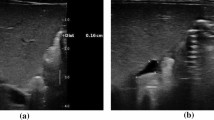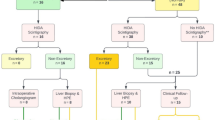Abstract
The objective is to explore the correlation between ultrasonic gallbladder length–width ratio (LTWR) and age, and the value of differential diagnosis between biliary atresia (BA) and other hepatic cholestasis. From January 2016 to June 2022, the data of 183 patients with jaundice who underwent abdominal ultrasound and surgical exploration in the Affiliated Hospital of Zunyi Medical University were analyzed retrospectively. The demographic data, liver function, and ultrasonic parameters were recorded and analyzed. There were statistically significant differences between BA group and non-BA group in maximum length, maximum width and LTWR of gallbladder (P < 0.001). In all age groups (I: ≤ 30 days; II: 31–60 days; III: 61–90 days; IV: 91–120 days; V: ≥ 121 days), in which group III (61–90 days) had the highest area under the curve (AUC) of 0.843, and group V (≥121 days) had the lowest AUC of 0.548. The sensitivity, specificity, positive predictive value, negative predictive value and accuracy of gallbladder LTWR > 3.26 for BA in group II (31–60 days) were 78.9%, 75.0%, 75.0%, 78.9% and 76.9%, respectively. The sensitivity, specificity, positive predictive value, negative predictive value and accuracy of gallbladder LTWR > 3.69 for BA in group III (61–90 days) were 76.6%, 84.6%, 92.5%, 59.5% and 78.9%, respectively. Ultrasonography LTWR of gallbladder has certain value in the diagnosis of BA. The diagnostic value of gallbladder LTWR in infants with different ages was quite different, and it was relatively high in infants with 31–90 days.


Similar content being viewed by others
Data availability
All data generated or analyzed during this study are included in this published article. Data are, however, available from the corresponding author upon reasonable request and with permission of the interviewees.
Abbreviations
- ALT:
-
Alanine aminotransferase
- AST:
-
Aspartate aminotransferase
- AUC:
-
Area under the curve
- BA:
-
Biliary atresia
- DBIL:
-
Direct bilirubin
- ERCP:
-
Endoscopic retrograde cholangiopancreatography
- GGT:
-
Gamma-glutamyl transferase
- IQR:
-
Interquartile range
- IOC:
-
Intraoperative cholangiography
- LTWR:
-
Length-to-width ratio
- SD:
-
Standard deviation
- TBIL:
-
Total bilirubin
References
Lendahl U, Lui V, Chung P, Tam P (2021) Biliary atresia-emerging diagnostic and therapy opportunities. EBioMedicine 74:103689. https://doi.org/10.1016/j.ebiom.2021.103689
Rabbani T, Guthery SL, Himes R, Shneider BL, Harpavat S (2021) Newborn screening for biliary atresia: a review of current methods. Curr Gastroenterol Rep 23(12):28. https://doi.org/10.1007/s11894-021-00825-2
Lakshminarayanan B, Davenport M (2016) Biliary atresia: A comprehensive review. J Autoimmun 73:1–9. https://doi.org/10.1016/j.jaut.2016.06.005
Schreiber RA, Harpavat S, Hulscher J, Wildhaber BE (2021) Epidemiology, screening and public policy. J Clin Med 11(4):999. https://doi.org/10.3390/jcm11040999
Chung PH, Wong KK, Tam PK (2015) Predictors for failure after Kasai operation. J Pediatr Surg 50(2):293–296. https://doi.org/10.1016/j.jpedsurg.2014.11.015
Yerina SE, Ekong UD (2021) Biliary Atresia/Neonatal cholestasis: what is in the horizon. Pediatr Clin North Am 68(6):1333–1341. https://doi.org/10.1016/j.pcl.2021.08.002
Napolitano M, Franchi-Abella S, Damasio BM et al (2021) Practical approach for the diagnosis of biliary atresia on imaging, part 2: magnetic resonance cholecystopancreatography, hepatobiliary scintigraphy, percutaneous cholecysto-cholangiography, endoscopic retrograde cholangiopancreatography, percutaneous liver biopsy, risk scores and decisional flowchart. Pediatr Radiol 51(8):1545–1554. https://doi.org/10.1007/s00247-021-05034-7
Chen X, Dong R, Shen Z, Yan W, Zheng S (2016) Value of Gamma-glutamyl transpeptidase for diagnosis of biliary atresia by correlation with age. J Pediatr Gastroenterol Nutr 63(3):370–373. https://doi.org/10.1097/MPG.0000000000001168
Lemoine C, Melin-Aldana H, Brandt K, Mohammad S, Superina R (2020) The evolution of early liver biopsy findings in babies with jaundice may delay the diagnosis and treatment of biliary atresia. J Pediatr Surg 55(5):866–872. https://doi.org/10.1016/j.jpedsurg.2020.01.027
Li Y, Jiang J, Wang H (2022) Ultrasound elastography in the diagnosis of biliary atresia in pediatric surgery: a systematic review and meta-analysis of diagnostic test. Transl Pediatr. 11(5):748–756
Ohyama K, Fujikawa A, Okamura T et al (2021) The triangular cord ratio and the presence of a cystic lesion in the triangular cord suggested new ultrasound findings in the early diagnosis of biliary atresia. Pediatr Surg Int 37(12):1693–1697
Duan X, Peng Y, Liu W, Yang L, Zhang J (2019) Does supersonic shear wave elastography help differentiate biliary atresia from other causes of cholestatic hepatitis in infants less than 90 days old? compared with grey-scale US. Biomed Res Int 2019:9036362. https://doi.org/10.1155/2019/9036362
Choochuen P, Kritsaneepaiboon S, Charoonratana V, Sangkhathat S (2019) Is, “gallbladder length-to-width ratio” useful in diagnosing biliary atresia. J Pediatr Surg 54(9):1946–1952. https://doi.org/10.1016/j.jpedsurg.2019.01.008
Zhou LY, Wang W, Shan QY et al (2015) Optimizing the US diagnosis of biliary atresia with a modified triangular cord thickness and gallbladder classification. Radiology 277(1):181–191. https://doi.org/10.1148/radiol.2015142309
Wang L, Yang Y, Chen Y, Zhan J (2018) Early differential diagnosis methods of biliary atresia: a meta-analysis. Pediatr Surg Int 34(4):363–380. https://doi.org/10.1007/s00383-018-4229-1
Wang Y, Jia LQ, Hu YX, Xin Y, Yang X, Wang XM (2021) Development and validation of a nomogram incorporating ultrasonic and elastic findings for the preoperative diagnosis of biliary atresia. Acad Radiol 28(Suppl 1):S55–S63. https://doi.org/10.1016/j.acra.2020.08.035
Liu Y, Xu R, Wu D et al (2021) Development and validation of a novel nomogram and risk score for biliary atresia in patients with cholestasis. Dig Liver Dis. https://doi.org/10.1016/j.dld.2021.09.015
El-Guindi MA, Sira MM, Konsowa HA, El-Abd OL, Salem TA (2013) Value of hepatic subcapsular flow by color doppler ultrasonography in the diagnosis of biliary atresia. J Gastroenterol Hepatol 28(5):867–872. https://doi.org/10.1111/jgh.12151
Zhou LY, Chen SL, Chen HD et al (2018) Percutaneous US-guided Cholecystocholangiography with microbubbles for assessment of infants with us findings equivocal for biliary atresia and gallbladder longer than 1.5 cm: a pilot study. Radiology 286(3):1033–1039
Funding
This work was supported by the Science and Technology Planning Project of Zunyi city, Guizhou Province of China (no. [2019] 104).
Author information
Authors and Affiliations
Contributions
Contributions: (I) conception and design: ZKZ, TY, and JZ; (II) administrative support: JZ; (III) provision of study materials or patients: all the authors; (IV) collection and assembly of data: all the authors; (V) data analysis and interpretation: all the authors; (VI) manuscript writing: ZKZ, JZ; (VII) final approval of manuscript: all the authors.
Corresponding author
Ethics declarations
Conflict of interest
No financial or non-financial benefits have been received or will be received from any party related directly or indirectly to the subject of this article.
Research involving human participants and/or animals
The Affiliated Hospital of Zunyi Medical University approved the study protocol.
Informed consent
Informed consent was waived.
Patient and public involvement
Patients and/or the public were not involved in the design, conduct, reporting or dissemination plans of this research.
Additional information
Publisher's Note
Springer Nature remains neutral with regard to jurisdictional claims in published maps and institutional affiliations.
Rights and permissions
Springer Nature or its licensor (e.g. a society or other partner) holds exclusive rights to this article under a publishing agreement with the author(s) or other rightsholder(s); author self-archiving of the accepted manuscript version of this article is solely governed by the terms of such publishing agreement and applicable law.
About this article
Cite this article
Zhang, K., Tang, Y., Zheng, Z. et al. Value of gallbladder length-to-width ratio for diagnosis of biliary atresia by correlation with age. Updates Surg 75, 915–920 (2023). https://doi.org/10.1007/s13304-022-01427-x
Received:
Accepted:
Published:
Issue Date:
DOI: https://doi.org/10.1007/s13304-022-01427-x




